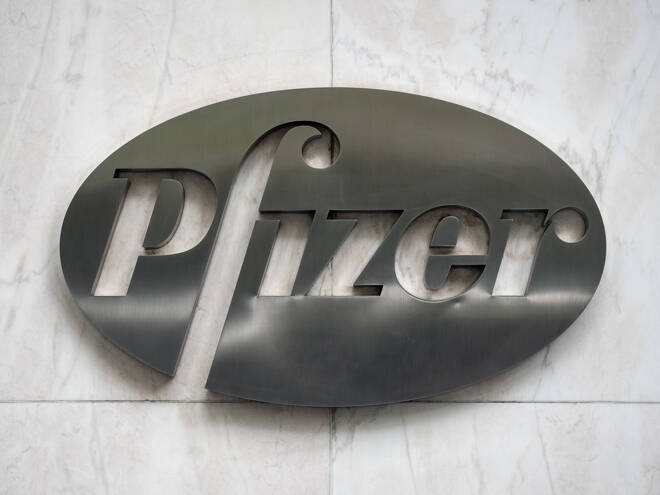Advertisement
Advertisement
COVID-19 Vaccine Update – Pfizer Inc. Approval Imminent Amidst a Virus Surge
By:
FDA feels the heat from the Whitehouse, as the U.S readies to begin Operation Warp. Vaccine availability will be an issue near-term, however.
In this article:
The Latest
On Thursday, U.S FDA advisors had voted 17-4 in favor of the BioNTech/Pfizer Inc. mRNA vaccine. The vaccine vote was for the FDA approval to be inclusive of 16 and 17-year-olds. Some FDA advisors were reportedly uncomfortable including the lower age bracket, however, which resulted in 4 votes against.
Over the course of the week, a continued rise in new COVID-19 cases and 3,000 related deaths each day mounted pressure on the FDA for rapid approval.
The markets had anticipated an FDA approval in a matter of days.
On Friday, however, the FDA notified BioNTech/Pfizer Inc. that it plans to authorize the use of the mRNA vaccine in the U.S.
There were reports, following the panel vote on Thursday that White House pressure was needed to force a swift FDA response to the panel vote.
Trump was back on Twitter on Friday, this time targeting the FDA.
It was another big week on the vaccine front. With an FDA green light now imminent and the UK already in vaccination mode, Canada’s health regulator also approved the Pfizer Inc. vaccine in the week.
Canada joined Bahrain, Britain, and Saudi Arabia as the first nations to approve the vaccine, with the U.S likely to be next to join a rapidly growing list.
What’s next?
For the U.S, the federal government’s vaccine distribution program will begin within 24-hours of approval. Known as Operation Warp Speed, the government will liaise with Pfizer Inc. to deliver the vaccine to the most vulnerable by the early part of next week.
As the FDA readies to formally approve the BioNTech/Pfizer Inc. EUA, the FDA is also due to review the Moderna Inc. vaccine next week.
There will be mounting pressure for more rapid review times as other pharmas begin to complete clinical trials.
With around 21 million healthcare personal and approximately 3 million long-term care facility residents (“LTCF”), Pfizer Inc. and Moderna Inc. will not have sufficient doses produced to vaccinate phase 1a recipients this year.
Following BioNTech/Pfizer Inc.’s supply chain issues, the U.S is now reportedly due to receive just 6.4 million doses this month. That falls well short of the 24 million phase 1a recipients prioritized by the CDC, let alone the 330 million U.S population.
The Latest COVID-19 Numbers
At the time of writing, the total number of confirmed COVID-19 cases stood at 71,414,262. The total number of U.S cases has risen to 16,290,412, with the total number of related deaths rising to 302,727.
Things are not much better in other parts of the world, with new cases continue to spike in the winter months.
This continued rise in new cases will place additional pressure on other nations to catch up with Britain and the few others that have already approved the vaccine.
For the EU, the EMA is not due to review the vaccine for another month…
Other Pharmas
With the BioNTech/Pfizer Inc. vaccine now being delivered and orders mounting, Moderna Inc. is next.
Last week, news of Sanofi and GlaxoSmithKline’s vaccine showing inadequate immune response in clinical trials was a blow.
This comes off the back of issues raised over AstraZeneca and the University of Oxford’s clinical trial parameters. With AstraZeneca having kicked off a global clinical trial just weeks, hopes are that a 3rd vaccine could be approved in early January.
With the pressure to deliver an effective vaccine building, news hit the wires on Friday of AstraZeneca joining Russian scientists in a bid to improve efficacy rates. British and Russian scientists are reportedly planning to see whether combining the respective shots would deliver better results.
Clinical trials are due to start at the end of the year. AstraZeneca will also be combining its vaccine with the BioNTech/Pfizer Inc. vaccine, with clinical trials set to start in January.
Based on the latest news, Johnson & Johnson is also aiming to deliver a vaccine in early 2021.
Expectations are that inoculations beyond high priority recipients would begin towards the end of the 1st quarter. This would be aligned with Johnson & Johnson and AstraZeneca’s conclusion of clinical trials and regulatory approvals.
The Global Financial Markets
While country approvals of BioNTech/Pfizer Inc.’s vaccine are positive, too few countries have approved the vaccine to-date.
Production capacity issues also mean that countries will not receive enough doses to vaccinate entire populations.
This leaves countries and economies at the mercy of the COVID-19 pandemic for longer than would be liked.
Once there are 3 to 4 effective vaccines available in the market place, however, conditions should improve.
An end to the winter flu season coinciding with widely available COVID-19 vaccines would allow governments to begin to fully reopen economies.
We should then see a more meaningful economic recovery, supported by both fiscal and monetary policy measures.
Some nations will lag, however. Delays in ordering vaccinations and the high price of the BioNTech/Pfizer Inc. and Moderna Inc. vaccines means that some nations will have to wait.
These economies will suffer for longer before any recovery can begin in earnest.
About the Author
Bob Masonauthor
With over 20 years of experience in the finance industry, Bob has been managing regional teams across Europe and Asia and focusing on analytics across both corporate and financial institutions. Currently he is covering developments relating to the financial markets, including currencies, commodities, alternative asset classes, and global equities.
Latest news and analysis
Advertisement
